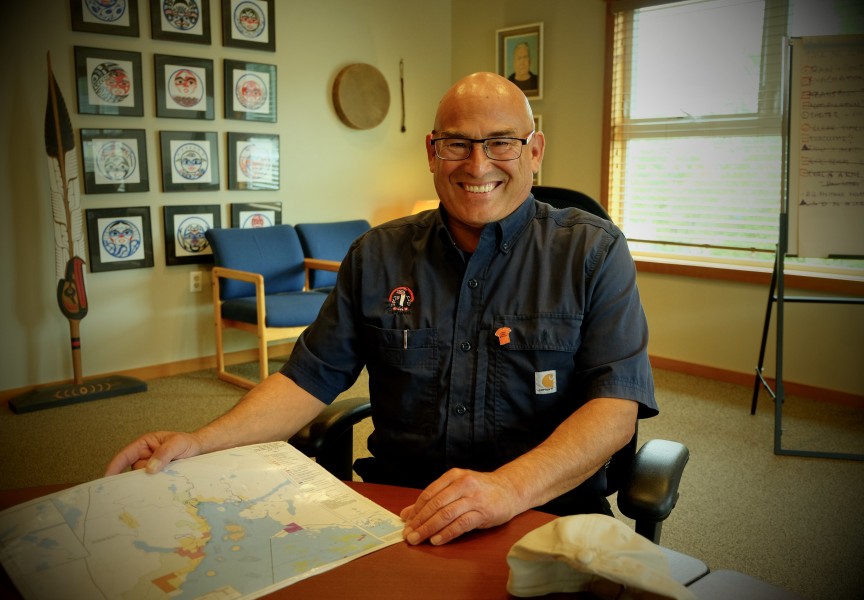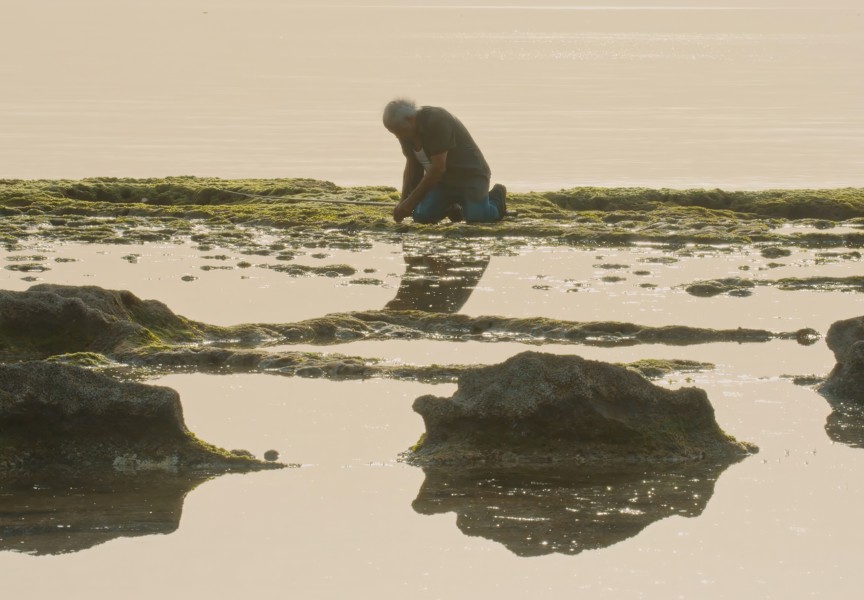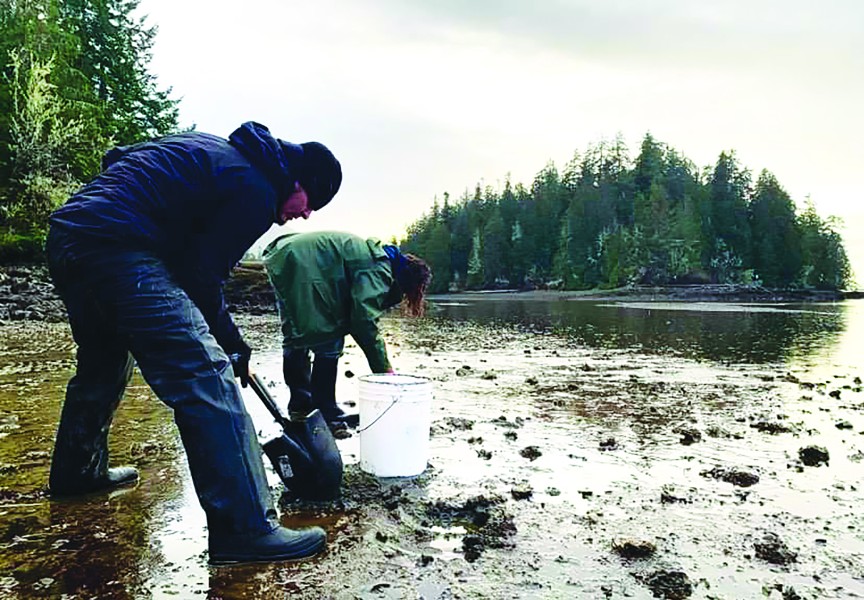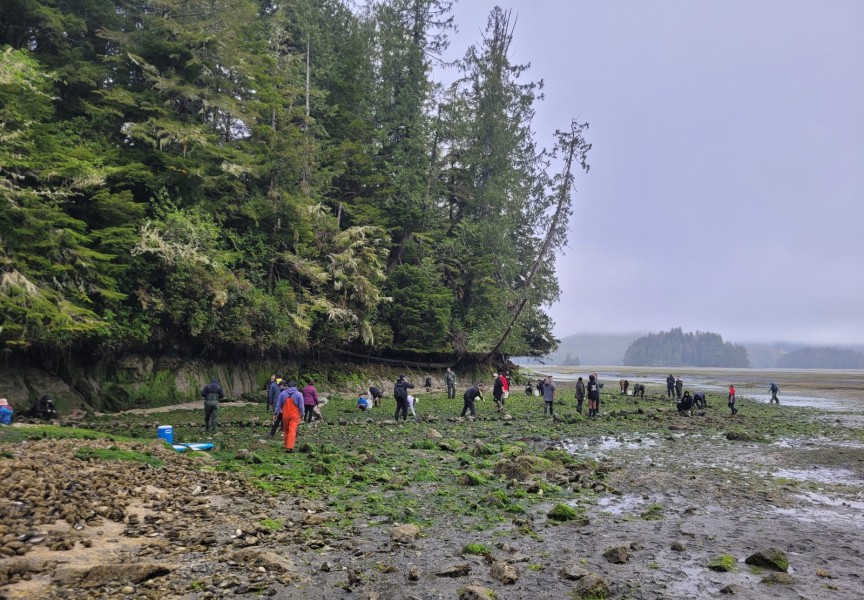This is article is part of a series of stories on Nuu-chah-nulth clam gardens.
Tofino dwindled in the distance as the water taxi followed a low, low spring tide out towards Meares Island Tribal Park or wanačas hiłhuuʔis, Nuu-chah-nulth words that translate to ‘the mountain and the shoreline’.
Elder Vince Smith was among the crew for the day, having journeyed roughly seven hours with family from Ehattesaht territory and the town of Zeballos on the northwest coast of Vancouver Island.
The purpose of the trip was to grow the hiłhuuʔis clam garden with the Nuu-chah-nulth Youth Warrior Family; Smith brought a notepad and pen to diarize the day and was eager to put shovels in the sand with his grandkids.
“I think it’s really important they learn something like this to bring back home. We didn’t do this when I was growing up,” said Smith, who attended the Christie Residential School on Meares Island for eight years and then was transferred to Mission.
As the group walked the cedar boardwalk to the site, Smith explained how Tofino and Ucluelet have one of the strongest currents on the west coast.
“It generates all the nutrients for everything that is on food chain,” Smith said. “The tides, they come off a Japanese current and it usually hits around the Tofino area. It causes a really strong tide here. It’s different here than up in Zeballos and the Esperanza area.”
It’s hard to know exactly how many clams a garden like hiłhuuʔis produce, but according to the Clam Garden Network, the sitescan yield 150 to 300 per cent more clams and double to quadruple the biomass of unmodified beaches.
Tribal Parks Guardian Gisele Martin says clams used to feed 10,000 Tla-o-qui-aht people for millennia. She pulled out her phone and brought up a map to show the group Felice Island, located between Clayoquot Island and Tofino. During the lowest tides, the land mass between Tofino and Felice would be exposed, allowing for Tla-o-qui-aht to harvest hundreds and hundreds of clams.
"In my grandfather’s time, newcomers used a conveyor belt machine to extract five tonnes of clams a day until they decimated the clam garden," Martin exclaimed. That's about the weight of four small cars.
“As soon as Tofino waterfront became their dump, we lost that clam garden place too. As more and more pollutants like fish farming and float homes came into our territory, there are polka dots of areas that are now closed to us (for shellfish harvesting),” said Martin.
Within minutes of arriving at the site, Youth Warrior program coordinator Dr. Ricardo Manmohan unearthed a dozen huge butter clams from a small patch of sand. He dropped them in a bucket and told the Ha-Shilth-Sa that Fisheries and Oceans Canada exempts butters from shellfish testing because they are not commercially viable, but these clams are the ones that elders like the most.
“It’s like paddling in the fog, we are learning as we go,” said Manmohan.
“The reason you build the wall is that it retains the spawn. When the clams let off all their spawn, it retains. You’ll see as the tide comes back up, you’ll see how it may be ripply on the outside, it’s really calm in the clamming area,” he explained.
The crew spent a couple hours raking seaweed and removing rocks from within the garden to create more room for the clams to burrow into the sand. They stacked the rocks along the intertidal terrace to make it more stable and then started building a new terrace.
Traditionally, clam harvesters would rotate each year between the different terraces or arches to allow for regrowth.
Youth Warrior program operations lead and Huu-ay-aht First Nation member Andrew Clappis Jr. was in his element, working the beach and spending time outdoors with friends.
“Moving rocks is a lot of fun,” he grinned. “Every time we come out here, there is always a heron in that same spot. I’ve heard that if you point at it, you get pregnant or your finger shrivels off.”
The Youth Warrior team has built two other clam gardens in Nuu-chah-nulth territory: one is on Huu-ay-aht shores in the south and the other is in Ka:’yu:’k’t’h/Che:k’tles7et’h First Nations territory on Vancouver Island’s northwest coast. Clappis says their focus for now is on maintaining the three sites rather than building more, although they’d love to be able to expand in the future.
When asked why they were committed to restoring clam gardens, Clappis Jr. took a long, thoughtful pause before sharing his answer:
“We are bringing back a major food source for when all the grocery stores shut down. It’s food sovereignty,” he said.
This story was made possible in part by an award from the Institute for Journalism and Natural Resources and the Gordon and Betty Moore Foundation.











